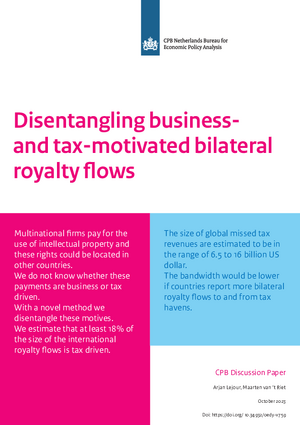Disentangling business- and tax-motivated bilateral royalty flows
This implies that bilateral royalty payments may not only be business motivated but may also be tax driven. We determine the shares of tax and business motivated flows. We estimate that at least 18% of the size of the flows is tax driven. The associated worldwide loss of tax revenue is between 6.5 and 16 billion US dollar.
Downloads
This bandwidth is caused by fact that some countries, such as Luxemburg, Singapore and the UK, do not report bilateral flows at all, and some other countries, such as Ireland and the Netherlands, only partially. Especially flows to and from tax havens are missing. For the estimations we use a new method that takes into account both the shifting of IP-rights and the use of sublicensing in conduit countries.
As an update on this discussion paper, the research 'Tax avoidance by redirecting royalty flows: estimating the global revenue loss' has been published in International Tax and Public Finance on March 18th, 2025.
Dat betekent dat de omvang van de royalty-betalingen van land naar land niet alleen zakelijke motieven hebben, maar ook door belastingmotieven bepaald kunnen zijn. We bepalen welk aandeel van deze betalingen belastinggemotiveerd is en welk deel zakelijk. We schatten dat tenminste 18% van de omvang van de stromen belastinggedreven is. Het hiermee gepaard gaande wereldwijde verlies aan belastinginkomsten bevindt zich tussen de 6,5 en 16 miljard dollar. De oorzaak van deze bandbreedte is dat sommige landen, zoals Luxemburg, Singapore en het Verenigd Koninkrijk, in het geheel geen bilaterale stromen rapporteren, en sommige andere landen, zoals Ierland en Nederland, dat slechts gedeeltelijk doen. In het bijzonder ontbreken de bilaterale stromen van en naar belastingparadijzen. Voor de schattingen gebruiken we een nieuw ontwikkelde methode die rekening houdt met zowel het verplaatsen van de IE-rechten, als met sublicenties in doorsluislanden.
Authors


Authors


